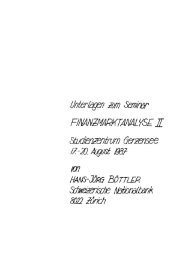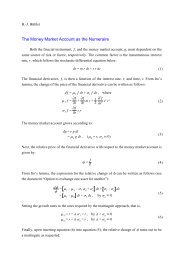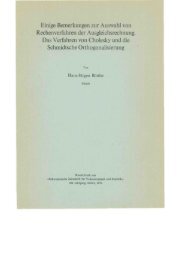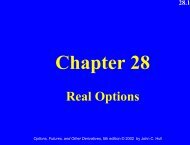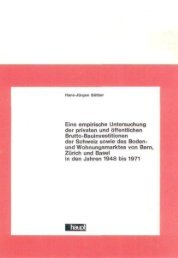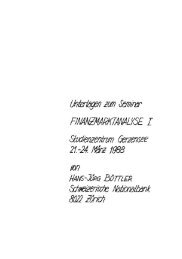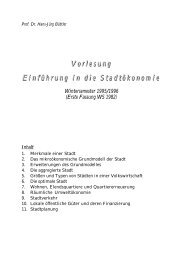Callable Bond/EJ/e
Callable Bond/EJ/e
Callable Bond/EJ/e
Create successful ePaper yourself
Turn your PDF publications into a flip-book with our unique Google optimized e-Paper software.
H.-J. Büttler: <strong>Callable</strong> <strong>Bond</strong>s: Finite Difference Methods 3<br />
x =<br />
1<br />
1 + mr , τ = t – t 0<br />
s – t 0<br />
, (0 ≤ x, τ ≤ 1), F(x, τ) = P(r, t). (2)<br />
Here, m;^ is a scaling factor, s the maximum time until expiration of all the bonds considered,<br />
and τ measures the elapsed time rather than the time to maturity (the differential equation is still<br />
solved backwards in time). The transformed differential equation then becomes (3).<br />
0 =<br />
∂F(x, τ)<br />
∂τ<br />
+ a(x)<br />
∂F(x, τ)<br />
∂x<br />
+ b(x) ∂2 F(x, τ)<br />
∂x 2<br />
+ c(x) F(x, τ), with<br />
a(x) = – (αγ + ρq) m x 2 – α (1 – x) x – ρ 2 m 2 x 3 (s – t 0<br />
) 0,<br />
b(x) = 1<br />
2 ρ 2 m 2 x 4 (1 – x)<br />
(s – t 0<br />
) > 0, c(x) = – (s – t 0<br />
) < 0.<br />
mx<br />
(3)<br />
Two comments are necessary. First, although we consider only non-negative interest rates in<br />
this paper, the transformation (2) allows for a negative interest rate range which is sufficient in<br />
practical applications, for instance, r > –100% for m;^ = 1. In fact, a calculation of the analytical<br />
price of a callable bond with twenty years to expiration and with ten call dates has shown that<br />
the smallest ‘break-even’ interest rate is –13% (Büttler and Waldvogel, 1993b). Secondly, the<br />
numerical error calculated in this paper is based on the analytical price for positive ‘break-even’<br />
interest rates (see footnote 3 of Table 3).<br />
Table 1: Finite Differences for Internal Mesh Points.<br />
Derivative Denominator F i + 1<br />
F i<br />
F i – 1<br />
Equal Interest F x 2 ∆x 1 — – 1<br />
Rate Interval F xx (∆x) 2 1 – 2 1<br />
Unequal Interest F x<br />
∆x + ∆x 0 1 — – 1<br />
Rate Interval F xx<br />
∆x ∆x 0<br />
[∆x + ∆x 0<br />
] 2 ∆x 0<br />
– 2 [∆x + ∆x 0<br />
] 2 ∆x<br />
Comment: Read the second row as F x<br />
= [1·F i + 1<br />
– 1·F i – 1<br />
] / [2 ∆x] and similarly the other rows. ∆x 0<br />
denotes the<br />
interval length to the left of the internal mesh point in question and ∆x the interval length to the right of this<br />
mesh point.<br />
The region of definition of the transformed differential equation, Ω = [0, 1] × [0, 1], is<br />
now divided into meshes. Since we wish to calculate the price of callable bonds for the current<br />
value of the instantaneous interest rate, the meshes are not all of the same size. Moreover, it<br />
might be desirable to have narrow meshes for small interest rates such that the ‘break-even’ interest<br />
rate can be determined with ‘high’ accuracy. Therefore, the x-axis is divided into n 1<br />
equal<br />
intervals between x m<br />
and 1 (equivalently r ∈ [0, r m<br />
]) and n 2<br />
equal intervals between 0 and x m<br />
(equivalently r ∈ [r m<br />
, + ∞]). If n 2<br />
is set equal to zero, then the whole range of positive interest<br />
rates is divided into n 1<br />
equal intervals, possibly except for an initial step at x = 0 (r = ∞). The<br />
current value of the instantaneous interest rate, r 0<br />
, lies always on a mesh point. The steps between<br />
two points in time of interest (e. g., a coupon date and a notice date) will be of equal<br />
length. The mesh points are counted with index i along the x-axis and with index j along the<br />
time axis.<br />
Royal Economic Society Conference University of Exeter, 28 – 31 March 1994



